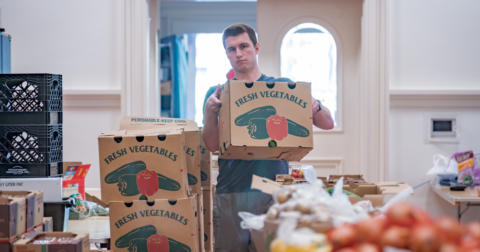Solutions
West Hollywood Committed to Plant-Based Food. Here’s What That Looks Like So Far
Climate•6 min read
News
How the “megabill” could undermine the push to eat more plants.


Words by Seth Millstein
Update: The Megabill passed the House again on Thursday, clearing the way for President Trump’s signature.
Senate Republicans passed the so-called “megabill” on Tuesday, a package of legislation that extends President Trump’s 2017 tax cuts by cutting funding for various domestic programs. One such program is the Supplemental Nutrition Assistance Program (SNAP), which subsidizes groceries for over 42 million low-income Americans every month. Before the megabill becomes law, it will need to be passed in identical form by the House of Representatives. The House passed a different version of the legislation in May, and the two chambers will need to reconcile the differences between the two versions of the bill before sending it to Trump to be signed.
If this version of the bill passes, the impact on SNAP will be substantial. Cutting SNAP funding would imperil millions of Americans’ access to fresh produce, and in doing so, seriously undermine the effort to get more Americans eating a healthier, plant-forward diet.
In its current form, the bill ensures that every state will have their SNAP funding cut to some degree. This will force cash-strapped states into a no-win situation: kick some recipients out of SNAP, or slash funding from other programs to keep them on. The bill would also limit future benefit increases for SNAP recipients and increase existing work requirements for SNAP eligibility, thus reducing enrollment in the program.
“It will make our economy poorer, and social mobility poorer,” Gina Plata-Nino, SNAP Deputy Director at the non-profit Food and Research Action Center, tells Sentient. “Because it won’t just affect those who are utilizing those benefits. It will affect all of us who live in this country.”
On a personal level, cutting SNAP benefits will make it harder for low-income Americans to feed themselves, and in many states, the cuts will specifically reduce access to fresh fruit, vegetables and other healthy foods.
Eating more whole foods is unquestionably good for your health, and, if those plant-forward foods also take the place of some of the beef in your diet, it’s also better for the planet.
There are a number of supplemental, state-based SNAP programs that aim to boost intake of healthy fruits and vegetables, offering recipients additional food dollars if they use their SNAP funds to buy these foods. Examples include Double Up Food Bucks and Wholesome Wave, both of which are offered in over 25 states, as well as individual state-based programs like Colorado’s SNAP Produce Bonus and Minnesota’s Market Bucks.
While these initiatives function in slightly different ways, there’s some evidence that shows that these kinds of plant-forward, supplemental SNAP programs do indeed increase the amount of fruits and vegetables that people purchase.
This matters, because in many low-income parts of the country, fresh fruits and vegetables are already difficult to come by. Diets rich in plants are correlated with a number of positive health outcomes so programs that grant people easier access to eating more plants are good for the planet and for public health.
These programs are made available to SNAP recipients. But if fewer people are eligible for SNAP in the first place due to the megabill’s funding cuts, fewer people will be eligible for this extra financial assistance to purchase fruits and vegetables.
The megabill contains a number of SNAP-related policies, but the most significant are the changes to the Thrifty Food Plan, work requirements and cost sharing. In total, these three changes will effectively cut SNAP funding by an estimated $131 billion over the next 10 years, according to estimates by the Congressional Budget Office (CBO).
The Thrifty Food Plan is a low-cost food plan that the USDA provides for low-income Americans, and it serves as the document that the USDA uses to determine SNAP benefit amounts. It was updated in 2021, and this update effectively increased SNAP benefits by about $1.19 a day per person — a significant boost, given that the average SNAP recipient only receives about $6 per day in benefits.
The megabill will freeze future updates to the Thrifty Food Plan. According to the CBO, this would effectively cut SNAP spending by about $37 billion over the next 10 years.
In addition to this, the megabill would expand the work requirements for SNAP recipients. Under current law, SNAP recipients have to abide by certain requirements in order to demonstrate that they’re actively seeking work and taking jobs that are offered to them.
This part of the megabill is relatively cut-and-dry. Currently, the work requirements only apply to SNAP recipients under 54 years of age, but the megabill will increase that threshold to 64 years. The CBO estimates that this would reduce SNAP funding by $69 billion over the next decade.
The most complex portion of the megabill’s SNAP changes is the shifting of funding from the federal government to the states.
Under current law, SNAP benefits themselves are funded entirely by the federal government, while the administrative costs of running the program are split 50-50 between the federal government and the states. The megabill modifies both of these arrangements.
First, it requires states to pay 75 percent of SNAP administration costs instead of 50 percent. This would be a direct cut to the federal government’s funding of SNAP, to the tune of $25 billion, and is rather straightforward.
The cuts to the benefits themselves are less straightforward, however. They will differ from state to state, and would be pegged to each state’s “error rate,” or the rate at which it has mistakenly over- or under-paid SNAP benefits in the past. Errors in SNAP payments are largely the result of unintentional mistakes on the part of administrators or recipients.
The CBO estimates that in totality, the Senate bill’s changes will decrease federal SNAP funding by about $40 billion over the next 10 years.
All but one state (South Dakota) has had an error rate of over six percent in at least one year over the last two decades, according to the Center on Budget and Policy Priorities, making it likely that at least some states will indeed be impacted by the benefits cuts. This is on top of the cuts to SNAP’s administrative funding, which will impact every state regardless of its error rate.
If a state is unable to fully fund its SNAP program due to the cut in federal funding, SNAP recipients won’t suddenly receive less money, according to Plata-Nino. Instead, the state will simply change its eligibility requirements such that fewer residents qualify for SNAP funds in the first place, effectively kicking some people out of the program.
“You can’t change the benefit [amount], as that’s set in the Farm Bill through the Thrifty Food Plan,” Plata-Nino explains. “The benefits will continue the same. It just means that less people will be eligible to participate.”
Alternatively, a state could instead choose to divert funds from other areas in order to cover the SNAP shortfall, which might allow it to continue distributing SNAP funds to all current recipients. But state budgets are already tight as is, and many states might not have the flexibility to do this — and even if they did, the programs from which funds were diverted would themselves become more financially hamstrung.
It’s also worth remembering amidst this that the megabill also requires every state to shoulder 75 percent of SNAP’s administrative costs, rather than the 50 percent they currently pay. This means that all 50 states would effectively have their SNAP funding cut to some degree, even if they have very low error rates.
In many lower-income or rural communities, local grocery stores rely heavily on SNAP recipients for business. If the number of SNAP recipients is cut, these stores will suffer, and some might go out of business.
That’s bad for the business owners, and it’s also bad for the newly unemployed workers at those businesses. But the consequences stretch beyond even them. As with any business, grocery stores pay various taxes to state and local governments in order to operate. When these establishments shut down, the governments in question no longer receive that tax revenue.
This means that cutting SNAP funding, in addition to affecting SNAP recipients directly, also risks cutting off important revenue streams for state and local governments. This budget shortfall, in turn, can imperil all sorts of other public services, from infrastructure projects to education funding and beyond.
“States are going to have to pick,” Plata-Nino says. “Are you really going to build that new road, or that new bridge, when it means that you’re going to have to cut off thousands, if not millions, of people from your [SNAP] program?”
These tradeoffs aren’t just hypothetical; in fact, one state has already cut funding from another program in anticipation of the megabill’s SNAP cuts. Last week, Texas Gov. Greg Abbott cut $60 million from the state budget that would have funded free groceries for children during the summer, and cited concerns over the megabill’s impact on SNAP funds as a reason.
“The people at the local level who are going to have to deal with this are very concerned about how they’re going to manage without federal revenue,” Plato-Nino says. “It’s going to be, ‘either we cut much-needed services, or we raise property taxes.’”
Although it’s been passed by both chambers of congress, the megabill still isn’t a done deal, because the House and Senate versions of the legislation were not identical. At this stage, Republican congressional leaders have two options.
The first is for the House to simply pass the Senate’s version of the bill. In theory, this is the simpler option, as it wouldn’t require writing any more legislation or holding a second vote in the Senate. According to the Hill and Politico, this is what Republicans plan on doing.
But it’s not yet clear that the Senate’s version has the votes to pass the lower chamber, as a number of House Republicans are furious at various changes the Senate made to the bill. Six House Republicans have threatened to vote against the Senate version; this gives Republican leadership little margin for error, given that the original House version only passed by one vote.
If this method fails, Republican congressional leaders from both chambers will need to meet and grind out a third, compromise version of the legislation, which would then need to be voted on and passed by both chambers. This would be an infinitely more complex process, and it would almost certainly require Republicans to miss their self-imposed July 4 deadline to pass the final bill.
Regardless of which path Republicans take, the megabill is on track to significantly shrink America’s flagship food assistance program, making it even harder for low-income Americans to access nutritious food than it already is.